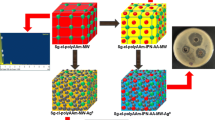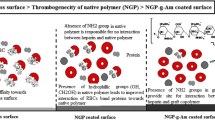Abstract
Microbial contamination, the consequences of both anthropogenic and geogenic activity, includes high health and environmental threats and may adversely affects the ecological niche. The present work is a successful attempt towards the fabrication of anti-bacterial agent by incorporation of cationic monomer, diallyldimethylammonium chloride (DADMAC) on sesbania gum through microwave assisted method. The grafted chains of poly (DADMAC) provide positive charge to sesbania gum which in turn confers antibacterial activity. The synthesized product was characterized through FTIR, SEM, TGA, DSC elemental and viscometric analysis. The inhibitory activity of the synthesized product has been evaluated in vitro against both Gram-positive (Staphylococcus aureus NCIM 2122 and Bacillus anthracis) as well as Gram-negative (Salmonella typhi NCIM 2501 and Escherichia coli NCIM 2832) bacteria through standard agar cup method. Optimum minimum inhibitory concentration for each grade of graft copolymer measured by calculating the zone of inhibition has been found at 750 µg/ml.
Graphical Abstract








Similar content being viewed by others
References
Allan GG, Altman LC, Bensinger RE, Ghose DK, Hirabayashi Y, Neogi AN, Neogi S (1984) Biomedical application of chitin and chitosan, In: Zikakis JP (ed) In: Chitin chitosan and related enzymes. Acedemic Press, New York, pp. 113–119
Sen G, Pal P (2009) A novel polymeric biomaterial based on carboxymethyl starch and its application in controlled drug release. J Appl Polym Sci 114(5):2798–2805
Mishra S, Mukul A, Sen G, Jha U (2011) Microwave assisted synthesis of polyacrylamide grafted starch (St-g-PAM) and its applicability as flocculant for water treatment. Int J Biol Macromol 48(1):106–111
Pal P, Pandey JP, Sen G (2017) Synthesis, characterization and flocculation studies of a novel graft copolymer towards destabilization of carbon nano-tubes from effluent. Polymer 112:159–168
Mahto D, Rani P, Mishra S, Sen G (2014) Microwave assisted synthesis of polyacrylamide grafted soya peptone and its application as water soluble adhesive. Ind Crops Prod 58:251–258
Whistler RL (1993) Exudate gums: industrial gums, polysaccharides and their derivatives. Academic Press, San Diego, pp 309–339
Levy G, Schwarz TW (1958) Tragacanth solutions I: the relation of method of preparation to the viscosity and stability. J Am Pharm Assoc 47(6):451–454
Phillips GO, Williams PA (2009) Handbook of hydrocolloids. Woodhead Publishing, Cambridge
Shaidi F, Arachchi JKV, Jeon YJ (1999) Food application of chitin and chitosan. Trends Food Sci Technol 10(2):37–51
Yamane S, Iwasaki N, Majima T, Funakoshi T, Masuko T, Harada K, Minami A, Monde K, Nishimura S (2005) Feasibility of chitosan-based hyaluronic acid hybrid biomaterial for a novel scaffold in cartilage tissue engineering. Biomaterials 26(6):611–619
Pelissari FM, Grossmann MVE, Yamashita F, Pineda EAG (2009) Antimicrobial, mechanical and barrier properties of cassava starch-chitosan films incorporated with oregano essential oil. J Agric Food Chem 57(16):7499–7504
Peng ZX, Wang L, Du L, Guo SR, Wang XQ, Tang TT (2010) Adjustment of the antibacterial activity and biocompatibility of hydroxypropyltrimethyl ammonium chloride chitosan by varying the degree of substitution of quaternary ammonium. Carbohydr Polym 81(2):275–283
Sen G, Mishra S, Usha Rani G, Rani P, Prasad R (2012) Microwave initiated synthesis of polyacrylamide grafted psyllium (Psy-g-PAM) and its applicationas flocculant. Int J Biol Macromol 50:369–375
Sen G, Singh RP, Pal S (2010) Microwave-initiated synthesis of polyacrylamide grafted sodium alginate: synthesis and characterization. J Appl Polym Sci 115:63–71
Ceresa RJ (1962) Block & graft copolymer. Butterworths, London
Je J, Kim SK (2006) Antimicrobial action of novel chitin derivative. Biochim Biophys Acta 1760(1):104–109
Rabea EI, Badawy MET, Steurbaut W, Stevens CV (2009) In vitro assessment of N-(benzyl) chitosan derivatives against some plants pathogenic bacteria and fungi. Eur Polym J 45(1):237–245
Coma V (2008) Current research and developments on chitin and chitosan in biomaterials sciences. Research Signpost, Trivandrum, pp 21–51
Zhang Q, Gao Y, Zhai YA, Liu FQ, Gao G (2009) Synthesis of sesbania gum supported dithiocarbamate chelating resin and studies on its adsorption performance for metal ions. Carbohydr Polym 73(2):359–363
Kongparakul S, Prasassarakich P, Rempel LG (2008) Effect of grafted methylmethacrylate on the catalytic hydrogenation of natural rubber. Eur Polym J 44(6):1915–1920
Pirgalioglu S, Ozbelge TA, Ozbelge HO, Bicak N (2015) Crosslinked poly(DADMAC) gels as highly selective and reusable arsenate binding materials. Chem Eng 262:605–617
Collins EA, Bares J, Billmeyer FW (1973) Experiments in polymer science. Wiley, New York
Adhikari S, Lohar S, Kumari B, Banerjee A, Bandopadhyay R, Matalobos JS, Das D (2016) Cu(II) complex of a new isoindole derivative: structure, catecholase like activity, antimicrobial properties and bio-molecular interactions. New J Chem 40:10094–10099
Miller ML (1996) The structure of polymers. Reinhold Publishing Corporation, New York
Razali MAA, Sanusi N, Ismail H, Othman N, Ariffin A (2012) Application of response surface methodology (RSM) for optimization of cassava starch grafted polyDADMAC synthesis for cationic properties. Wiley, New York, pp 1–9
Park SH, Wei S, Mizaikoff B, Taylor AE, Favero CD, Huang CH (2009) Degradation of amine-based water treatment polymers during chloramination as N-nitrodimethylamine (NDMA) precursors. Environ Sci Technol 43(5):1360–1366
Lokesh P, Luzinova Y, Cho M, Mizaikoff B, Kim JM, Huang C (2011) Poly DADMAC and dimethylamine as precursors of N-nitrosodimethylamine during ozonation: reaction kinetics and mechanisms. Environ Sci Technol 45(10):4353–4359
Mazloumpour M, Malshe P, El-Shafei A, Hauser P (2013) Conferring durable antimicrobial properties on nonwoven polypropylene via plasma-assisted graft polymerization of DADMAC. Surf Coat Technol 224:1–7
Liu F, Ma B, Zhou D, Zhu L, Fu Y, Xue L (2015) Positively charged loose nanofiltration membrane grafted by diallyldimethyl ammonium chloride (DADMAC) via UV for salt and dye removal. React Funct Polym 86:191–198
Liu XF, Guan YL, Yang DZ, Li Z, Yao KD (2001) Antibacterial action of chitosan and carboxymethylated chitosan. J Appl Polym Sci 79:1324–1335
Jia Z, Shen D, Xu W (2001) Synthesis and antibacterial activities of quaternary ammonium salts of chitosan. Carbohydr Res 333(1):1–6
Rabea EI, Badawy MET, Stevens CV, Smagghe G, Steurbaut W (2003) Chitosan as antimicrobial agent: application and mode of action. Biomacromolecules 4(6):1457–1465
Zhao L, Mitomo H, Zhai M, Yoshii F, Nagasawa N, Kume T (2003) Synthesis of antibacterial PVP/CM-chitosan blend hydrogels with electron beam irradiation. Carbohydr Polym 53(4):439–446
Singh RP (1995) Advanced drag reducing and flocculating materials based on polysaccharides, In: Mark JM, Fai TJ (eds) Polymers and other advanced materials: emerging technologies and business opportunities. Plenum Press, New York, pp 227–249
Singh RP, Karmakar GP, Rath SK, Karmakar NC, Pandey SR, Tripathy T (2000) Biodegradable drag reducing agents and flocculants based on polysaccharides: materials and applications. Polym Eng Sci 40(1):46–60
Yamazaki M, Hudson SM (2012) Chitosan derivatives for bioadhesive/hemostatic application: chemical and biological aspects, In: Lucia LA (eds) Polysaccharide building blocks: a sustainable approach to the development of renewable biomaterials. Wiley, New Jersey, pp 199–226
Acknowledgements
Pinki Pal acknowledges the Department of Science and Technology (DST), India, for the research grant (sanction order No. SR/WOS-A/ET-13/2014). The authors also acknowledge the support of CIF-BIT Mesra and CHN lab, Punjab University, Chandigarh. We are also thankful to UGC-CAS, Department of Botany, The University of Burdwan. AB and UH are also thankful for the financial assistance to SRF and JRF accordingly.
Author information
Authors and Affiliations
Corresponding author
Rights and permissions
About this article
Cite this article
Pal, P., Banerjee, A., Halder, U. et al. Conferring Antibacterial Properties on Sesbania Gum via Microwave-Assisted Graft Copolymerization of DADMAC. J Polym Environ 26, 3272–3282 (2018). https://doi.org/10.1007/s10924-018-1213-8
Published:
Issue Date:
DOI: https://doi.org/10.1007/s10924-018-1213-8




